Pluto used to be considered the farthest planet from us. Until astronomers discovered many other icy objects orbiting the sun around Pluto, poor Pluto was downgraded in 2006 Since Pluto was discovered by TOMBO in 1930, it was downgraded in 2006, only 76 years. Pluto's revolution cycle is 247.94 years, so from discovery to degradation, it only rotates a small angle around the sun.
Although Pluto has been downgraded to a dwarf planet, scientists have not ignored this "little brother" at all. For scientists, the dwarf planet is full of mystery.
Pluto is small and far away, about 3 billion miles away. Even the best telescopes can only see a faint spot.

This is the best picture of Pluto ever taken by the Hubble Space Telescope
The Hubble Space Telescope can only capture 20 pixels of Pluto. Scientists can only know that some places are bright and some places are dark. They can't know what they are.
All scientists can know about Pluto is that it has nitrogen ice, a satellite and other limited information.
So to uncover the mystery of Pluto, you have to visit it there.
In the summer of 2015, the mission of NASA's new horizons (also known as new horizon) probe was to visit Pluto.
When the first photos came back, the scientists were shocked! What they expected to see was a flat and dead world similar to our moon.
But on the contrary, these photos show a dazzling world of diversity. There are towering mountains, winding glaciers and vast plains without craters. All these suggest that Pluto seems to be alive due to recent geological activities
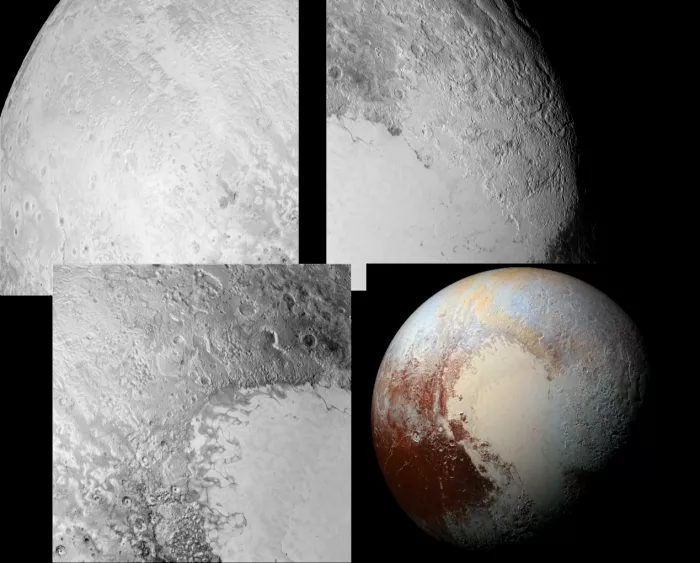
The picture of Pluto, in the lower right corner, is the famous "love"
From the photos sent back by new horizons, scientists found that some features could not be explained by simple theories.
Ice volcano on Pluto
What puzzles scientists most is that Pluto has some huge mounds on its surface. There is a deep depression at the top of each mound. These mounds look like young volcanoes.
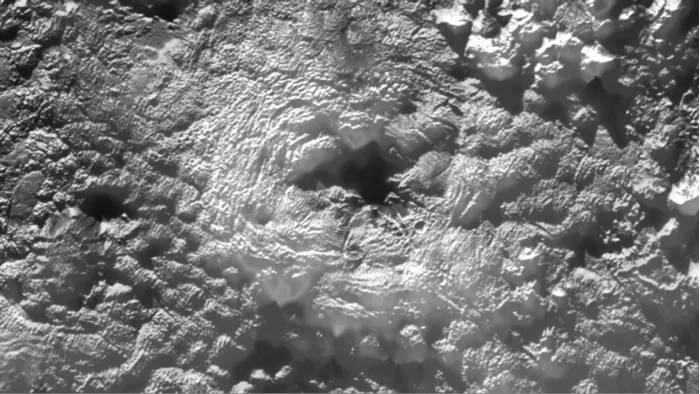
A huge mound on Pluto's surface
But how can there be volcanoes on the surface of a planet mainly composed of ice?
If you see something like this on earth, you will say, "it's a volcano"; If you see it on Mars, you'll still say, "it's a volcano.".
However, when you see it on Pluto, you must think, "what's this?"
Nothing on Pluto should drive volcanoes, so what are these?
The mysterious mound on Pluto is huge, more than 100 miles wide and about 3 miles high.
To understand these puzzling structures, scientists studied similar features on earth**
In Iceland, there is a volcano called "schiarbreze volcano", which means "wide shield" in Icelandic language. Planetary geologists call this volcano "shield volcano".
Shield volcanoes are formed by the eruption of flowing lava for a long time. They are shaped like shields of soldiers and placed on the ground.
Shield shaped mountain craters are seen on Pluto, and scientists think they may be shield volcanoes. Because its shape is very wide, and there is a crater on the top of the mountain like schiarbrazer volcano.
Shield volcanoes are not uncommon on other planets. For example, Mars and earth are mostly composed of rocks. Beneath Mars lies the largest volcano in the solar system, Mount Olympus. It's also a shield volcano. These shield volcanoes were formed by massive eruptions of hot lava millions of years ago.
But lava is molten rock, so the problem comes. Pluto is too far from the sun to melt. But if such features are really volcanic, they must be formed by something very different from lava.
Obviously, Pluto cannot erupt lava. Its surface is not made of basalt. On the contrary, it is made of water ice.
The bedrock of Pluto's crust is frozen nitrogen, while the mantle is solid water ice.
Some of the water ice must have melted for some reason, forming an explosive stream of liquid mud sprayed onto Pluto's surface. Like the fiery rock lava on earth, the warm snow mud quickly freezes on the surface, forming a vast ice shield
So the volcano on Pluto is not a volcano on a rocky planet, but an iceberg, a cold volcano
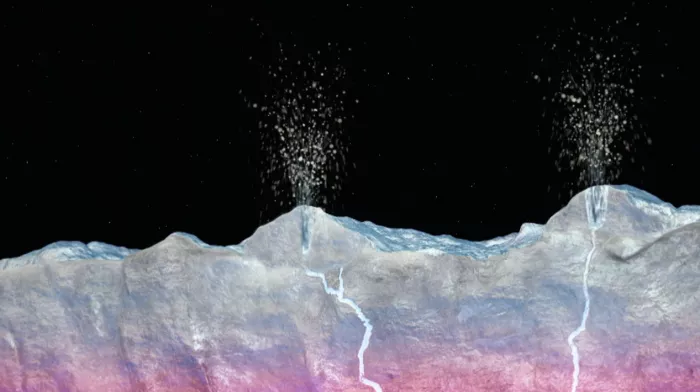
Schematic diagram of ice volcano formation on Pluto
Apart from the icy volcanoes on Pluto, the most exciting thing for scientists is that they have few craters. This means that the warm snow mud that formed the ice volcano must have flowed out recently. These characteristics are very, very young.
In other words, Pluto is definitely not a dead world. It is still very active today. Because there is not enough time for comets to hit Pluto and form historical marks under the bombardment. Pluto, it's still active, and there's the possibility of an active volcano.
[love on Pluto]
I believe that for many people, the most remarkable feature of Pluto is that "love".
For scientists, this huge heart-shaped basin is full of mystery. Because this Texas sized ice basin seems to be boiling.
Our solar system is full of scars of violence, and impact craters are scattered on the surfaces of rocky planets and planetary moons.
But on earth, the scars of these wars have been erased by lava, water and wind. But if you look at the moon now and then a thousand years later, the moon at these two time points will not be very different.
So scientists have always thought that Pluto has many craters, just like our moon, is a geologically dead world. But when scientists see this heart-shaped plain on Pluto, it looks much younger than on other planets. And there are no craters in this plain.
This heart-shaped plain, named "Sputnik plain" by scientists, looks like a glacier on earth. So there must be something that makes the surface so smooth. Something will level the plains of Sputnik regularly.
But what?
Scientists can rule out the possibility of ice volcanoes. Because they form mountains, not plains.
What else could it be?
The first clue comes from the pale serpentine lines, which seem to extend to the northern edge of the plain. These winding landforms look like glaciers formed by mountain glaciers on earth.
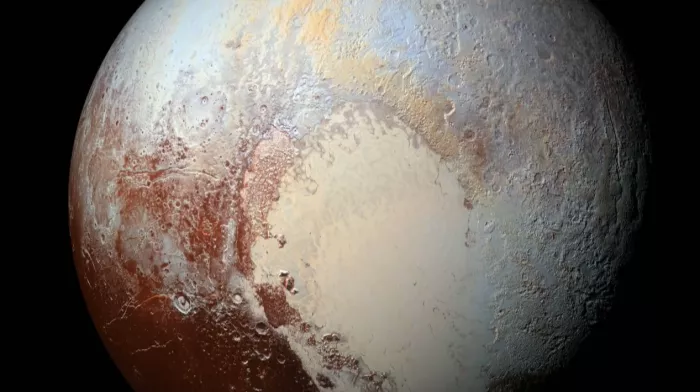
Nitrogen glaciers are formed in the north of Sputnik plain
There must be ice flowing out of Pluto's highlands, just like Pluto's highlands on Pluto.
But Pluto is too cold for water ice to flow, so the source of supply to the Sputnik plain must be a very different kind of ice, which is composed of substances such as nitrogen.
Nitrogen is the main material that makes up the atmosphere. Although it is a gas, at Pluto's temperature, it will freeze and become a glacier composed of nitrogen.
Scientists now believe that Sputnik plain is a huge basin full of frozen nitrogen. Fresh nitrogen flows steadily from mountain glaciers in the north, which also explains why the edge of the basin is so smooth.
But now there is another problem. There are also no craters in areas outside the glacier flow range. So scientists think there must be something else clearing the crater in the center of the basin.
A strange pattern on the Sputnik plain shows an amazing possibility... The surface of Pluto may be boiling!
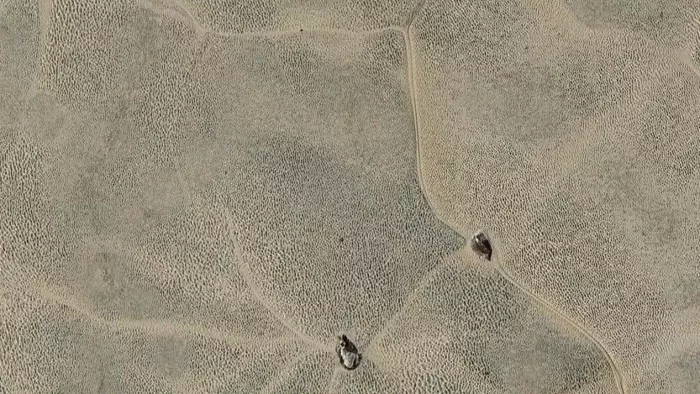
Partial close-up of Sputnik plain
When scientists looked at the surface of the Sputnik plain, they noticed regular intervals between the grids. There is a little roundness in the middle, and the edge becomes thinner gradually. It looks very much like... Formed by convection.
So you can think of it as a can of oatmeal. When it boils, it will bring the substance below to the surface, and then convection again and again, and pull it back to both sides.
Nitrogen ice on Putnik plain may boil like a pot of oatmeal, but the boiling surface looks frozen and slow at any time.
A similar but much faster process is the mosaic pattern formed in the most active lava lake on earth. The hot lava mass rises and forms a circular lattice on the surface, while the cooled lava sinks and slides between the cracks formed by the hot bubbles of the lava.
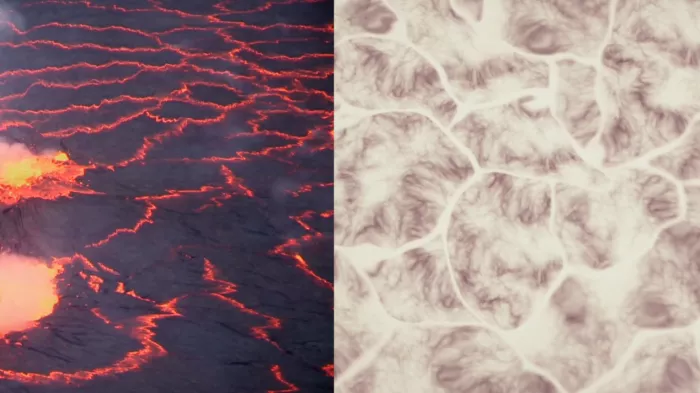
Comparison of lava lake on earth and nitrogen ice lake on Pluto
So when we look at the surface of Sputnik plain, what we see is basically a slow-moving lava lake. When the temperature rises, the material rises, then moves, and then sinks after the temperature drops.
If we can accelerate it over thousands of years, we can see that a single lattice on the surface is full of convective nitrogen, which will keep tumbling, stirring, boiling and moving.
Then there's another problem, although it doesn't take a lot of energy for cold things like nitrogen ice to flow. But it does need some energy. So where does the heat come from?
[where does Pluto drive the heat of the ice volcano come from]
When Pluto first formed 4 billion years ago, it was a hot planet, but Pluto was too small to retain this heat for a long time. And it's so far from the sun that the sun has little effect on Pluto. So scientists never thought it would be an active world.
If the heat that drives Pluto's geological activity does not come from sunlight, it must come from below. Scientists speculate that Pluto has a deep ocean of underground liquid water, which in some way raises heat to the surface.
If Pluto has a huge ocean of water inside, as time goes by, the planet gets cold and the water will freeze. When water freezes, it releases an energy called latent heat.
Therefore, the energy released by the frozen ocean is likely to be the main driving force of Pluto's geological activities **
Frozen water can really heat the planet! That sounds crazy! But it could be true.
Physical knowledge tells us that when water freezes, it does release heat. This is why scientists believe that latent heat in the underground ocean may lead to ice volcanism on Pluto.
The uppermost layer of the inner ocean freezes where liquid water meets the hard ice above. During the freezing process, latent heat is released, and the latent heat propagates upward through Pluto's crust, which promotes the geological activity on Pluto's surface.
Although water will only release a little heat in the process of freezing, if an entire layer of ocean is frozen by the ice shell, it will produce huge heat.
Therefore, the ice volcanoes may only be driven by the heat generated by the freezing of some liquid water in the ocean.
We humans live on this warm planet, so we often form an inherent "bias" that a lot of energy is needed to drive volcanoes, geysers and plate tectonics.
In fact, this is not the case. If the rock is to melt, it must consume a lot of energy. But ice doesn't need that much energy.
So on Pluto, if something can heat it a little and get melted water ice, it will produce the same surface geological phenomena as on earth
If our Galaxy were filled with frozen worlds like Pluto, the universe would be much more interesting.
So if most of the worlds in the Milky way are cold, it is possible that most of the volcanic activity in the Milky way is actually the cold volcanic activity we see on Pluto.
Pluto has changed our view of solid planets. Planets in a cold world are not dead worlds.
[ask the question of life again]
Pluto is likely to have both heat and liquid water. This simple fact has led scientists to ask an "old-fashioned" question again: can micro Pluto, 3 billion miles from the sun, become a secret refuge for life?
In the vast space, we only know that one planet is the home of life, that is our planet, the earth.
On earth, we have all the elements needed for life - energy, liquid water and organic molecules. We used to think that the earth was the only world with these three elements. But when robotic probes visited Jupiter and Saturn, they found many active moons whose underground oceans were heated by hot volcanic vents. And these worlds also seem to contain the basic chemicals of life.
Since Jupiter's moon Europa and Saturn's moon Enceladus are considered potential refuge for life, why can't Pluto's underground ocean?
Now that Pluto has two elements needed for life, will the organic chemistry of the third element, carbon based molecules, exist on Pluto?
Astronomers believe that these complex chemicals can form spontaneously in cold space. As long as there is a simple carbon based gas and an energy source, usually light, more complex organic compounds will be formed.
Titan's atmosphere is filled with simple gases: methane, carbon monoxide and ammonia. When sunlight hits the top of Titan's clouds, these gases combine to form complex organic molecules suspended in the atmosphere, forming a dense haze.
Scientists call these naturally occurring organic molecules "SOLIN". This is a general term for any complex red organic molecule. These molecules are formed by the splitting and recombination of simpler molecules.
These organic molecules, called "SOLIN", you can think of them as Lego blocks of life. On earth, SOLIN like chemicals make up the cells that run life, and then DNA and proteins make life work.
If Pluto has a carbon rich atmosphere like Titan, it will also produce SOLIN.
In 2015, when the New Horizons spacecraft turned its back to the sun and took pictures of the dwarf planet. Scientists hope to capture a clear mist of this active organic chemical.
The results were much more spectacular than scientists had expected. A beautiful blue nitrogen ring surrounds Pluto, as we see on earth. These beautiful blue haze layers are the chemical manufacturing plants that produce SOLIN.
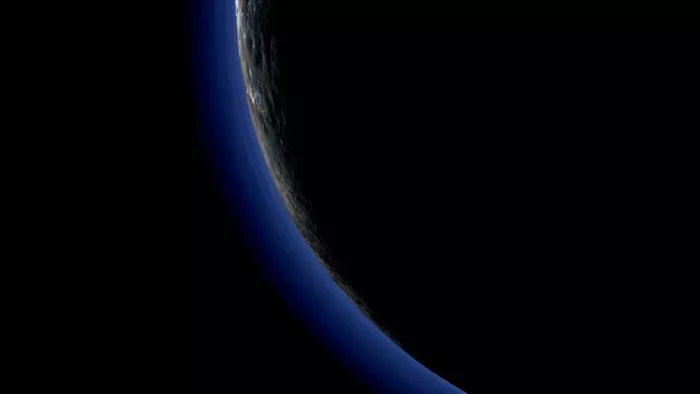
The blue nitrogen ring around Pluto
In fact, the color photos of Pluto show the rich red, orange and brown features on the surface, which is the evidence of organic chemistry.
But life is impossible on Pluto's surface because it's too cold. But if Sorin were circulated inside the planet, they might be transported to areas where ice melts into liquid water.
The chemical evolution of these simple organic molecules is likely to continue driven by Pluto's weak heat. Perhaps, the mechanism of simple life can be assembled in Pluto's subsurface ocean. Just like in the deep sea of the earth 4 billion years ago.
The reason why scientists see the existence of living elements on other planets outside the earth will ask the "old-fashioned" question: "is there life there?" Because, as human beings, we hope to find life on other planets outside the earth, even if we find traces of life. In this way, we can further understand whether life is universal in the universe and whether we exist alone.
[Pluto's companion]
Prior to the arrival of new horizons, the Hubble Space Telescope had found five satellites around Pluto. Charon is a giant moon relative to Pluto. The other four are much smaller ice satellites.

Pluto and its moons photographed by the Hubble Space Telescope
This picture is very blurred, so one of the missions of new horizons is to study these satellites and try to find any other satellites.
Scientists differ on whether Pluto has other moons. But new horizons confirmed that Hubble had seen everything it could see.
But Pluto's five moons are a very incredible world. With the exception of the oversized Charon, the other four satellites are Knicks, Hydra, coporos and stex, all of which are less than 40 kilometers in diameter.
Unlike any satellite astronomers have seen before, these objects rotate much faster than scientists expected. Not only that, their magnetic poles are not aligned with Pluto's magnetic poles. They actually spin on one side and then around Pluto.
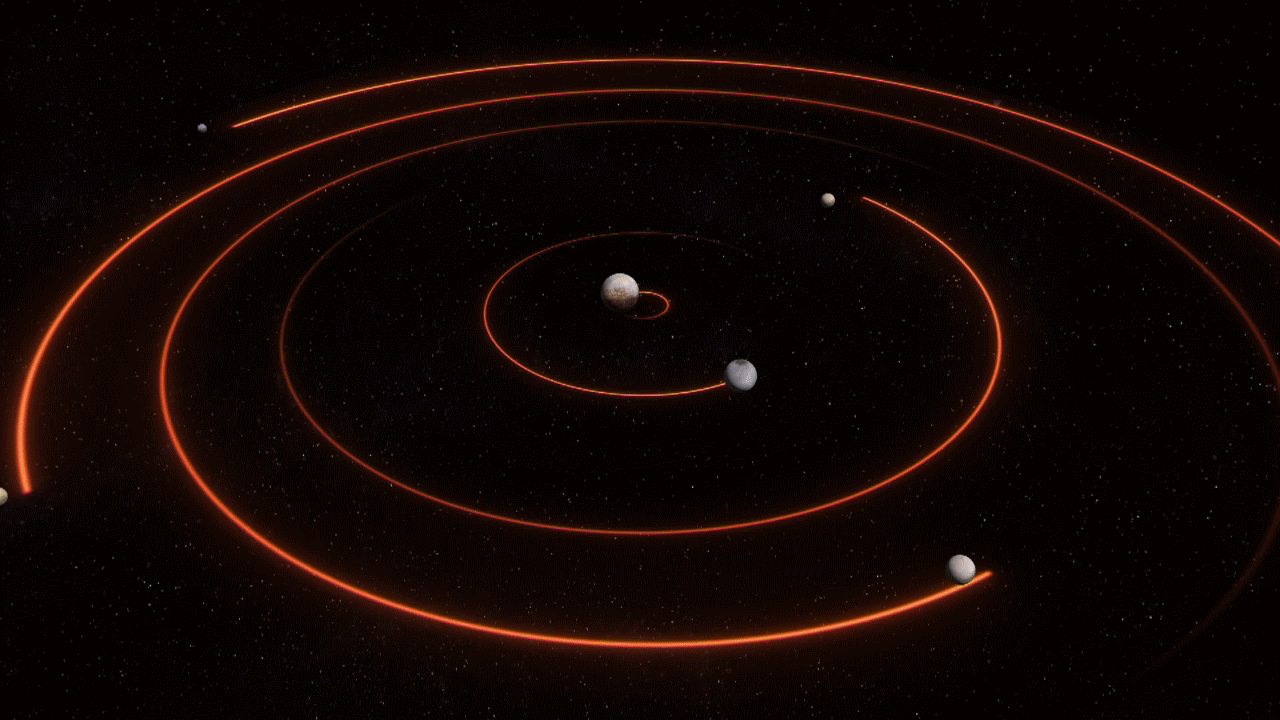
Motion chart of Pluto and its companion stars
To understand these crazy orbits, scientists looked for clues in the early history of the earth.
In the early days of the formation of the Kuiper belt, these ice bodies often collided with each other, just like what happened on earth. A protoplanet the size of Mars collided with the earth to form our Earth Moon system.
This may also happen on Pluto. Pluto probably suffered a huge impact when it was young, and its moon is the remnant of this huge collision. The giant Charon and Pluto entered a close spinning orbit. Further afield, four small satellites orbit the two celestial bodies like falling ice fragments.
The image of oversized Charon shows a gray, dead world. It's covered with scars from a violent past. The biggest scar is huge. It almost divides the satellite into two, and looks like someone smashes it completely with a hammer and chisel, and then smashes it together.
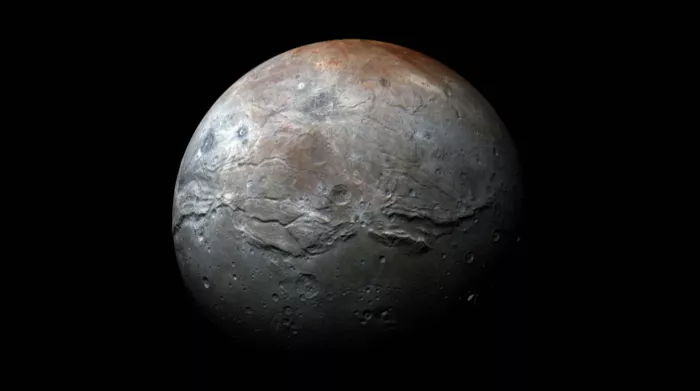
Charon (Charon)
But what is the power that can make a Texas sized satellite like Charon look like this?
Scientists believe there is only one option: water!
Four billion years ago, Charon also had a liquid ocean inside, just like Pluto today. But because Charon is smaller, it cools faster and the whole ocean turns into ice. We knew that water would expand abnormally when it turned into ice, so poor Charon cracked. Canyons and faults across the Charon equator are proof of this.
In addition, Charon's red polar cap also attracted the attention of mission scientists. They call it the "eye of Sauron". Yes, it's the evil eye in the Lord of the rings.
Because it is red and covered with some kind of red substance, scientists think it may be a kind of SOLIN. The eye of Sauron seems to be full of Saurin, but how is it possible?
The frozen world doesn't have the ingredients and atmosphere to make complex organic molecules, so SOLIN must have come from somewhere else.
But where did it come from?
The only reasonable answer is from Pluto 10000 miles away. But how did it come to Charon from Pluto? At present, scientists are not sure. Perhaps just like its name, this "eye of Sauron" is full of mystery.
[liquid nitrogen exists on Pluto's surface]
When scientists looked at pictures of Pluto, one picture caught their attention. There seem to be some depressions and waterways in this picture, which look like lakes and even rivers. Those flow features are made of nitrogen. Although they are now frozen, they seem to be liquid in recent geological history.
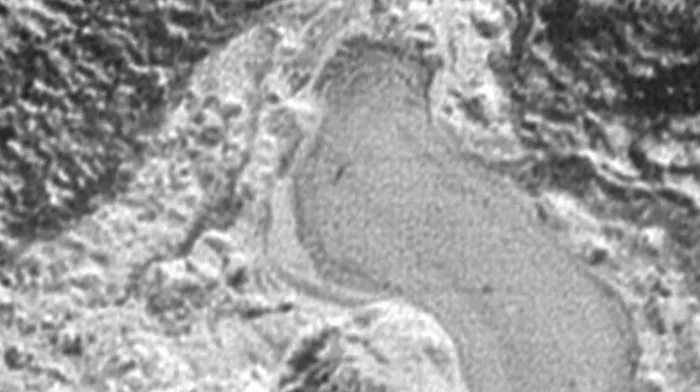
Frozen "Lake" on Pluto
But how could this happen? Pluto is too cold and its atmosphere is too thin to hold liquid on its surface.
Throughout the universe, liquids are hard to get. Everything seems to want to become solid or gas. There must be a suitable environment to contain liquid substances.
Therefore, even things like nitrogen should not only raise the temperature and make the nitrogen warm, but also have a certain atmospheric pressure. A thicker atmosphere is needed to maintain the liquid nitrogen on the surface.
Scientists speculate that Pluto must have warmed up in the past million years, evaporating glaciers and filling the atmosphere with nitrogen.
But what caused such extreme climate change?
Scientists first looked at Pluto's slender orbit around the sun. Every 248 years, Pluto's elliptical orbit brings it close to the sun.
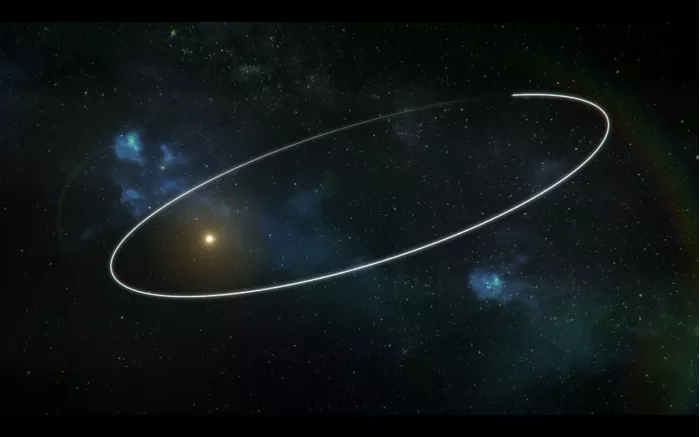
Pluto's elliptical orbit
But this brief warming is not enough to thicken Pluto's atmosphere. When it is close to the sun, it will run faster and faster, and when it is far away from the sun, it will run much slower.
So on Pluto, summer won't be as long as winter. However, due to the unstable tilt of the dwarf planet, Pluto's hemisphere will usher in a super summer from time to time.
From the way Pluto's north and south poles swing over time, scientists know that the top of Pluto's rotating sphere is not as stable as earth.
Its poles drift over time, and Pluto tilts completely to one side every million years or so. As it passes close to the sun, it exposes the northern hemisphere to continuous sunlight. The heat generated by orbital movement changes the surface of the planet.
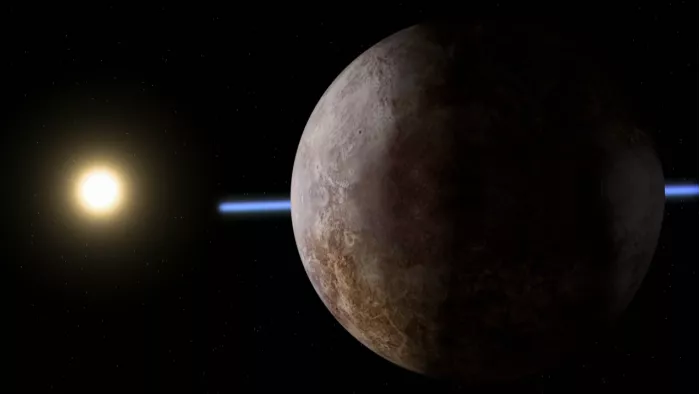
Every million years or so, Pluto tilts completely to one side
At this time, Pluto will become relatively warm, the atmosphere will become thicker and full of clouds, the warm wind will sweep across the plain, and Pluto's glaciers will begin to melt. Just as animals wake up from hibernation, Pluto wakes up.
Pluto has been experiencing periodic changes of warming and cooling in the past and in the future.
So, in 800000 years, Pluto will wake up again, it will tilt completely towards the sun, and its mountains will be filled with the sound of nitrogen flow. On the shore of nitrogen lake, pink snow with organic molecules will fall on the ground. This is a magical world.
Through the detection of Pluto by the new horizons probe, it tells us that there is a huge stage of life and a variety of worlds in the Milky way. This is also Pluto's Revelation to all of us.
It tells us that things outside are much more wonderful than you think.